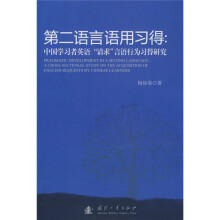第2语言语用习得:中国学习者英语请求语言行为习得研究

目 录内容简介
Chapter One Introduction.
1.1 Research background
1.2 Significance of the present study
1.3 Organization of the book
Chapter Two Acquisitional Issues in Interlanguage Pragmatics
2.1 Pragmatic competence
2.1.1 Communicative competence
2.1.2 A working definition of pragmatic competence
2.2 The definition and scope of Intedanguage Pragmatics (ILP)
2.3 The theoretical perspectives of L2 pragmatic acquisition
2.3.1 Cognitive processing
2.3.2 Relevance theory (RT)
2.3.3 The complexification hypothesis
2.4 Factors influencing L2 pragmatic acquisition
2.4.1 Classroom instruction
2.4.2 Pragmatic transfer
2.4.3 Grammatical competence
2.5 Methodology in doing acquisitional research
2.5.1 Developmental research designs
2.5.2 Data collection instruments
2.6 Summary
Chapter Three Studies on the Speech Act of Requests
3.1 Definition and taxonomy of requests
3.1.1 Defining requests
3.1.2 A taxonomy of requests
3.2 Illocutionary aspects of requests
3.2.1 Request strategies
3.2.2 Internal modification (1M)
3.2.3 External modification (EM)
3.3 Studies on the speech act of requests
3.3.1 Cross-cultural research on requests
3.3.2 Developmental research on requests
3.3.3 Studies on requests by Chinese researchers
3.4 Summary
Chapter Four Research Design
4.1 Research questions
4.2 Informants
4.2.1 Criteria in selecting informants
4.2.2 Learner informants
4.2.3 Native informants
4.3 Research instruments
4.3.1 Background questionnaire
4.3.2 Developing request scenarios..
4.3.3 The production questionnaire and sociopragmatic assessment questionnaire
4.4 Data collection
4.5 Data analysis framework
4.5.1 Request strategies
4.5.2 Internal modification
4.5.3 External modification
4.5.4 Procedures of data analysis
4.6 Summary
Chapter Five Data Analysis and Discussion
5.1 Request strategies
5.1.1 Total number of strategies
5.1.2 Directness
5.1.3 Conventional indirectness
5.1.4 Non-conventional indirectness (Hints)
5.1.5 Combination of individual strategies
5.1.6 Opting out
5.1.7 Summary and discussion of request strategies
5.2 Internal modification
5.2.1 Overall per[ormanee of internal modification
5.2.2 Syntactic downgraders
5.2.3 Lexical/phrasal downgraders
5.2.4 Upgraders
5.2.5 Combination of IM
5.2.6 ZerolM
5.2.7 Summary and discussion of internal modification
5.3 External modification
5.3.1 Overall performance of supportive moves
5.3.2 Employment of supportive moves by situation
5.3.3 Summary and discussion of external modification
5.4 Situational variation in requesting behavior
5.4.1 Sociopragrnatic assessment questionnaire
5.4.2 Assessment of social parameters across groups
5.4.3 Assessment of social parameters across situations
5.4.4 Perception of social parameters and choice of request strategies
5.4.5 Summary and discussion of sociopragmatic competence
5.5 The effect of L1 pragmatic transfer on L2 request acquisition
5.5.1 Request strategies and L1 influence
5.5.2 lntenal modification and L1 influence
5.5.3 External modification and L1 influence
5.5.4 Summary of transfer effect
5.6 Summary: Overall developmental features of English requests
Chapter Six The Role of Instruction in [2 Pragmatic Development
6.1 Negative effect of instruct}on on 1_2 pragmatic development
6.1.1 Metapragmatic input
6.1.2 Classroom discourse
6.1.3 Grammar-oriented Pedagogy
6 2 Need for instruction of L2 pragmatics
6.2.1 Curricula
6.2.2 Teaching materials
6.2.3 Instruction of L2 speech acts
6.3 Summary
Chapter Seven Conclusion
7.1 Summary of findings
7.2 Factors influencing L2 pragmatic development
7.3 Limitations of the present study and directions for future research
References
Appendix 1 Questionnaire for Chinese learners
Appendix 2 Questionnaire for Chinese native speakers
Appendix 3 Qnestiomnaire for English native speakers...
1.1 Research background
1.2 Significance of the present study
1.3 Organization of the book
Chapter Two Acquisitional Issues in Interlanguage Pragmatics
2.1 Pragmatic competence
2.1.1 Communicative competence
2.1.2 A working definition of pragmatic competence
2.2 The definition and scope of Intedanguage Pragmatics (ILP)
2.3 The theoretical perspectives of L2 pragmatic acquisition
2.3.1 Cognitive processing
2.3.2 Relevance theory (RT)
2.3.3 The complexification hypothesis
2.4 Factors influencing L2 pragmatic acquisition
2.4.1 Classroom instruction
2.4.2 Pragmatic transfer
2.4.3 Grammatical competence
2.5 Methodology in doing acquisitional research
2.5.1 Developmental research designs
2.5.2 Data collection instruments
2.6 Summary
Chapter Three Studies on the Speech Act of Requests
3.1 Definition and taxonomy of requests
3.1.1 Defining requests
3.1.2 A taxonomy of requests
3.2 Illocutionary aspects of requests
3.2.1 Request strategies
3.2.2 Internal modification (1M)
3.2.3 External modification (EM)
3.3 Studies on the speech act of requests
3.3.1 Cross-cultural research on requests
3.3.2 Developmental research on requests
3.3.3 Studies on requests by Chinese researchers
3.4 Summary
Chapter Four Research Design
4.1 Research questions
4.2 Informants
4.2.1 Criteria in selecting informants
4.2.2 Learner informants
4.2.3 Native informants
4.3 Research instruments
4.3.1 Background questionnaire
4.3.2 Developing request scenarios..
4.3.3 The production questionnaire and sociopragmatic assessment questionnaire
4.4 Data collection
4.5 Data analysis framework
4.5.1 Request strategies
4.5.2 Internal modification
4.5.3 External modification
4.5.4 Procedures of data analysis
4.6 Summary
Chapter Five Data Analysis and Discussion
5.1 Request strategies
5.1.1 Total number of strategies
5.1.2 Directness
5.1.3 Conventional indirectness
5.1.4 Non-conventional indirectness (Hints)
5.1.5 Combination of individual strategies
5.1.6 Opting out
5.1.7 Summary and discussion of request strategies
5.2 Internal modification
5.2.1 Overall per[ormanee of internal modification
5.2.2 Syntactic downgraders
5.2.3 Lexical/phrasal downgraders
5.2.4 Upgraders
5.2.5 Combination of IM
5.2.6 ZerolM
5.2.7 Summary and discussion of internal modification
5.3 External modification
5.3.1 Overall performance of supportive moves
5.3.2 Employment of supportive moves by situation
5.3.3 Summary and discussion of external modification
5.4 Situational variation in requesting behavior
5.4.1 Sociopragrnatic assessment questionnaire
5.4.2 Assessment of social parameters across groups
5.4.3 Assessment of social parameters across situations
5.4.4 Perception of social parameters and choice of request strategies
5.4.5 Summary and discussion of sociopragmatic competence
5.5 The effect of L1 pragmatic transfer on L2 request acquisition
5.5.1 Request strategies and L1 influence
5.5.2 lntenal modification and L1 influence
5.5.3 External modification and L1 influence
5.5.4 Summary of transfer effect
5.6 Summary: Overall developmental features of English requests
Chapter Six The Role of Instruction in [2 Pragmatic Development
6.1 Negative effect of instruct}on on 1_2 pragmatic development
6.1.1 Metapragmatic input
6.1.2 Classroom discourse
6.1.3 Grammar-oriented Pedagogy
6 2 Need for instruction of L2 pragmatics
6.2.1 Curricula
6.2.2 Teaching materials
6.2.3 Instruction of L2 speech acts
6.3 Summary
Chapter Seven Conclusion
7.1 Summary of findings
7.2 Factors influencing L2 pragmatic development
7.3 Limitations of the present study and directions for future research
References
Appendix 1 Questionnaire for Chinese learners
Appendix 2 Questionnaire for Chinese native speakers
Appendix 3 Qnestiomnaire for English native speakers...
目 录内容简介
《第2语言语用习得:中国学习者英语请求语言行为习得研究》在中介语语用学(Interlanguage Pragmatics)理论指导下,研究母语为汉语的学习者英语语用能力习得的特点和规律。采取横向设计,收集不同英语水平的学习者产生的英语“请求”言语行为语篇并分别与英、汉语本族语者语料进行比较发现:不同语言水平的学习者的语用能力处于不同的发展阶段,其“请求”言语行为体现出不同的中介语特征。除语言水平外,学习者二语语用能力的习得过程受母语语用迁移、课堂教学中的语用输入等因素的影响。本研究的发现对语用教学的大纲制定和教学过程具有一定的指导作用。
比价列表
公众号、微信群
 缺书网
缺书网微信公众号
 扫码进群
扫码进群实时获取购书优惠






